Cdc42 regulation of kinase activity and signaling by the yeast p21-activated kinase Ste20
- PMID: 11940652
- PMCID: PMC133773
- DOI: 10.1128/MCB.22.9.2939-2951.2002
Cdc42 regulation of kinase activity and signaling by the yeast p21-activated kinase Ste20
Abstract
The Saccharomyces cerevisiae kinase Ste20 is a member of the p21-activated kinase (PAK) family with several functions, including pheromone-responsive signal transduction. While PAKs are usually activated by small G proteins and Ste20 binds Cdc42, the role of Cdc42-Ste20 binding has been controversial, largely because Ste20 lacking its entire Cdc42-binding (CRIB) domain retains kinase activity and pheromone response. Here we show that, unlike CRIB deletion, point mutations in the Ste20 CRIB domain that disrupt Cdc42 binding also disrupt pheromone signaling. We also found that Ste20 kinase activity is stimulated by GTP-bound Cdc42 in vivo and this effect is blocked by the CRIB point mutations. Moreover, the Ste20 CRIB and kinase domains bind each other, and mutations that disrupt this interaction cause hyperactive kinase activity and bypass the requirement for Cdc42 binding. These observations demonstrate that the Ste20 CRIB domain is autoinhibitory and that this negative effect is antagonized by Cdc42 to promote Ste20 kinase activity and signaling. Parallel results were observed for filamentation pathway signaling, suggesting that the requirement for Cdc42-Ste20 interaction is not qualitatively different between the mating and filamentation pathways. While necessary for pheromone signaling, the role of the Cdc42-Ste20 interaction does not require regulation by pheromone or the pheromone-activated G beta gamma complex, because the CRIB point mutations also disrupt signaling by activated forms of the kinase cascade scaffold protein Ste5. In total, our observations indicate that Cdc42 converts Ste20 to an active form, while pathway stimuli regulate the ability of this active Ste20 to trigger signaling through a particular pathway.
Figures
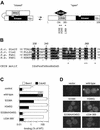
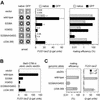
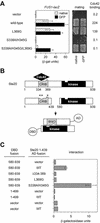
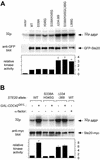
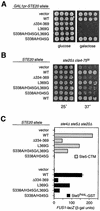
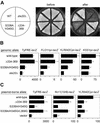

References
-
- Ayscough, K. R., J. Stryker, N. Pokala, M. Sanders, P. Crews, and D. G. Drubin. 1997. High rates of actin filament turnover in budding yeast and roles for actin in establishment and maintenance of cell polarity revealed using the actin inhibitor latrunculin-A. J. Cell Biol. 137:399-416. - PMC - PubMed
-
- Bagrodia, S., and R. A. Cerione. 1999. Pak to the future. Trends Cell Biol. 9:350-355. - PubMed
-
- Bartel, P. L., and S. Fields. 1995. Analyzing protein-protein interactions using two-hybrid system. Methods Enzymol 254:241-263. - PubMed
Publication types
MeSH terms
Substances
Grants and funding
LinkOut - more resources
Full Text Sources
Molecular Biology Databases
Miscellaneous
